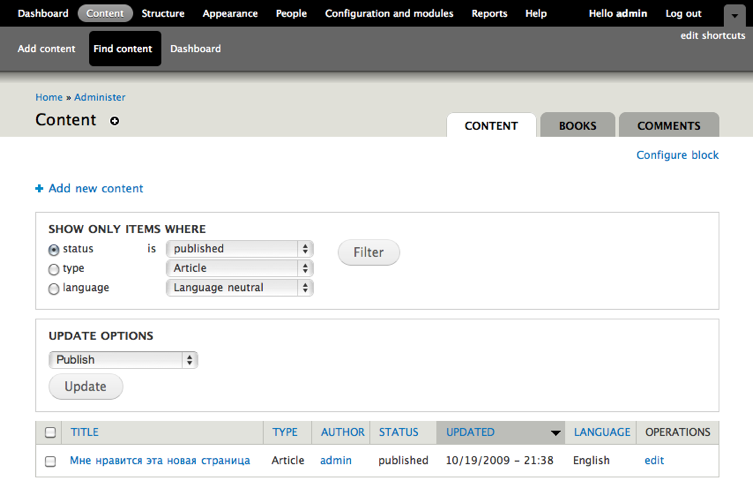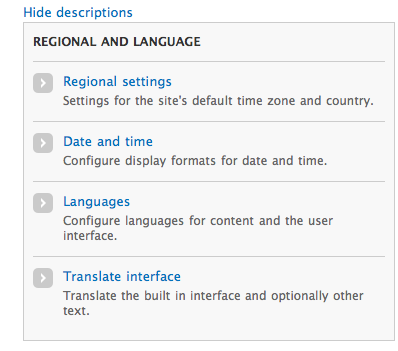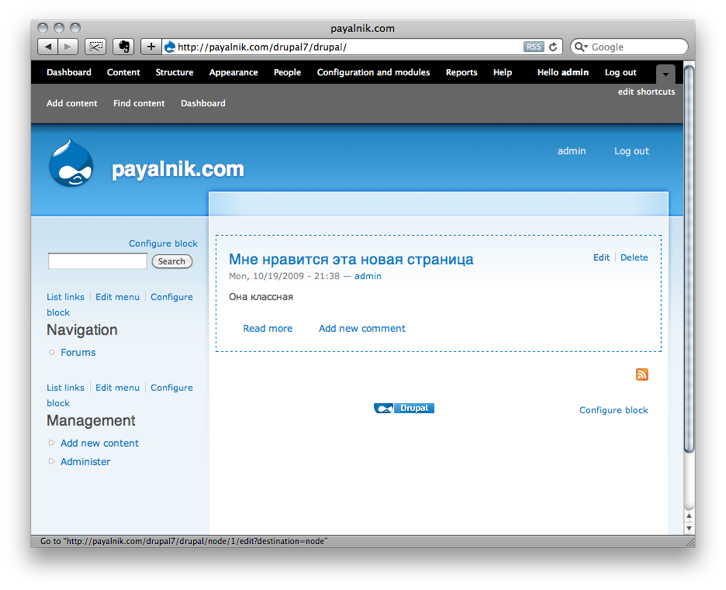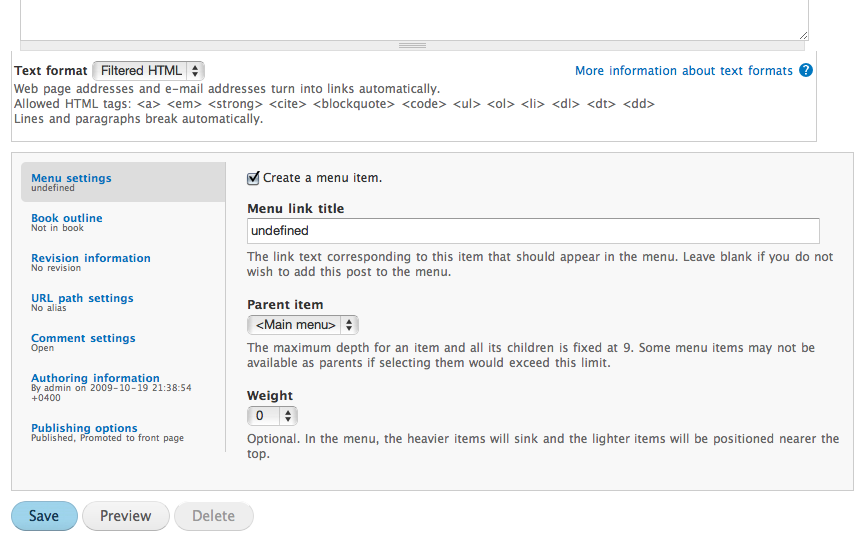Drupal 7: news from the front
Finally, the development of Drupal 7 has reached a state where the result can be put and tried (before that I tried to install the current build many times, but errors killed hope before the installation was completed). So I’m telling everyone interested in what’s new for us in Drupal.
First of all, a little about the development cycle. In early September, Code Freeze was announced: it stopped accepting patches that add or change the functionality and API of Drupal. After that, until October 15, patches of strictly limited subjects were taken (to finish everything started), and now only bug fixes are used. There are still a few months before the release, there are a lot of problems, but it is hoped that the automated testing frameworks implemented for this version will help fix them faster. This year's release will not be accurate, and the beta is unlikely to rush.
The main set of changes for Drupal is the adjustment to the users' wishbones, the integration of the functionality of the very popular "apish" modules into the core of the system and the polishing of the most disgusting corners of its software interfaces. The direction “semi-framework, half-cms” remains unchanged.
')
So, what users will see:
New admin theme . Changed as a visual design (it has become much more modern), and the logic of work:

Now the panel with links to popular sections of the menu is always on top. The admin panel itself has been reconfigured, the “content”, “structure”, “users” and “view” sections have been removed.


It seemed to me logical, but slightly unusual for experienced drupalists (although I seem to be relearned very quickly). It is frustrating, however, that the menu on top is not a dropout: I myself always put the admin_menu module, which draws the less logical (in the old logic) from above, but more convenient because of the drop-down menu items. But the second row of links (shortcuts) can be customized.
Further. Now the Content module (CCK) functionality is built into the Drupal core , and we can create content types with different fields:

Among the field types are “file” and “image”. Yes, you can attach files and images from the box to the content. Moreover, the functionality of the image_cache module, which prepares different versions of pictures for previews, resize, etc., will be built into Drupal.
From the inside it is terribly important for us that the taxonomy and user profile fields are now also content fields. All this is called the Field API (this is the main new API in the new Drupal release) and saves us from one of the modules that almost everyone had to install, and at the same time from the “Do it on CCK / write with your hands” holivar.
By the way, the standard content types have changed a bit: now Story is called more understandable Article, and by default a tag field has been added for them. Ouvdpressili, well, great. For convenience, the Path and Search modules now work by default.
An automatic update of the modules and the kernel is being prepared. Users will be notified when new versions are released by email. Cron.php cannot be started without a security key (or you can not launch it at all - the new Drupal launches it on one of the user's requests if it has not been called for a long time), and the installation and update scripts, on the contrary, started working from the command line.
Explanatory notes appeared in the access rights sheet! Urya!

A new section with regional settings has appeared:

Changes are noticeable in the interface of the site itself: for example, for all editable elements - blocks, menus and content - the corresponding links appeared. Conveniently.

By the way, the block editing interface itself has become much better - firstly, it is more logical, and secondly, finally, you can pull the block out of it into the desired region:

Finally, one of the most pleasant news was the revision of a huge form of content editing and editing. That's really really timely:

What was removed: old themes, setting the theme for each user separately, limiting the minimum length of the content header, choosing “whether to include beautiful URLs” (ask!).
Inside Drupal, there was a significant change in the database access API (previously, programmers had to regexps! Correct requests from other modules). It has become much more transparent and correct. However, there are no significant improvements in performance. Those who want to use Drupal for high-load projects (and, by the way, more and more recently) still have to add their caching and load-reducing tricks. However, work in this direction is underway: in addition to the ability to use other DBMS engines and MySQL to scale more flexibly thanks to the new API, a great deal of work is being done on integrating external search indexers (the Apache Solr module, like many others, will be ready for the day of Drupal 7 release) In the next incarnation, the Views module that many people need will have extended caching and support for various data sources - you can get data directly from the same Solr or, for example, Sphinx. Unfortunately, it’s still early to look at the new Views.
Of course, it is too early to use the new version as a platform for projects, even if the development cycle is long enough. But look should start now.
First of all, a little about the development cycle. In early September, Code Freeze was announced: it stopped accepting patches that add or change the functionality and API of Drupal. After that, until October 15, patches of strictly limited subjects were taken (to finish everything started), and now only bug fixes are used. There are still a few months before the release, there are a lot of problems, but it is hoped that the automated testing frameworks implemented for this version will help fix them faster. This year's release will not be accurate, and the beta is unlikely to rush.
The main set of changes for Drupal is the adjustment to the users' wishbones, the integration of the functionality of the very popular "apish" modules into the core of the system and the polishing of the most disgusting corners of its software interfaces. The direction “semi-framework, half-cms” remains unchanged.
')
So, what users will see:
New admin theme . Changed as a visual design (it has become much more modern), and the logic of work:

Now the panel with links to popular sections of the menu is always on top. The admin panel itself has been reconfigured, the “content”, “structure”, “users” and “view” sections have been removed.


It seemed to me logical, but slightly unusual for experienced drupalists (although I seem to be relearned very quickly). It is frustrating, however, that the menu on top is not a dropout: I myself always put the admin_menu module, which draws the less logical (in the old logic) from above, but more convenient because of the drop-down menu items. But the second row of links (shortcuts) can be customized.
Further. Now the Content module (CCK) functionality is built into the Drupal core , and we can create content types with different fields:

Among the field types are “file” and “image”. Yes, you can attach files and images from the box to the content. Moreover, the functionality of the image_cache module, which prepares different versions of pictures for previews, resize, etc., will be built into Drupal.
From the inside it is terribly important for us that the taxonomy and user profile fields are now also content fields. All this is called the Field API (this is the main new API in the new Drupal release) and saves us from one of the modules that almost everyone had to install, and at the same time from the “Do it on CCK / write with your hands” holivar.
By the way, the standard content types have changed a bit: now Story is called more understandable Article, and by default a tag field has been added for them. Ouvdpressili, well, great. For convenience, the Path and Search modules now work by default.
An automatic update of the modules and the kernel is being prepared. Users will be notified when new versions are released by email. Cron.php cannot be started without a security key (or you can not launch it at all - the new Drupal launches it on one of the user's requests if it has not been called for a long time), and the installation and update scripts, on the contrary, started working from the command line.
Explanatory notes appeared in the access rights sheet! Urya!

A new section with regional settings has appeared:

Changes are noticeable in the interface of the site itself: for example, for all editable elements - blocks, menus and content - the corresponding links appeared. Conveniently.

By the way, the block editing interface itself has become much better - firstly, it is more logical, and secondly, finally, you can pull the block out of it into the desired region:

Finally, one of the most pleasant news was the revision of a huge form of content editing and editing. That's really really timely:

What was removed: old themes, setting the theme for each user separately, limiting the minimum length of the content header, choosing “whether to include beautiful URLs” (ask!).
Inside Drupal, there was a significant change in the database access API (previously, programmers had to regexps! Correct requests from other modules). It has become much more transparent and correct. However, there are no significant improvements in performance. Those who want to use Drupal for high-load projects (and, by the way, more and more recently) still have to add their caching and load-reducing tricks. However, work in this direction is underway: in addition to the ability to use other DBMS engines and MySQL to scale more flexibly thanks to the new API, a great deal of work is being done on integrating external search indexers (the Apache Solr module, like many others, will be ready for the day of Drupal 7 release) In the next incarnation, the Views module that many people need will have extended caching and support for various data sources - you can get data directly from the same Solr or, for example, Sphinx. Unfortunately, it’s still early to look at the new Views.
Of course, it is too early to use the new version as a platform for projects, even if the development cycle is long enough. But look should start now.
Source: https://habr.com/ru/post/72867/
All Articles